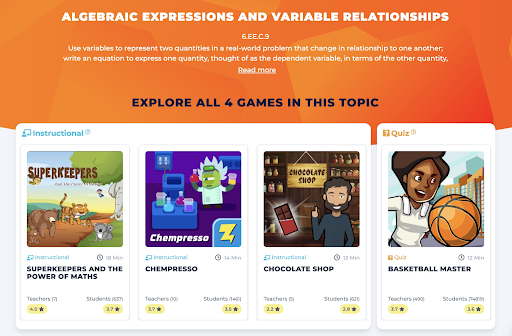Differentiation is an idea that has been thrown around in education, but what that means to educators and how that translates to the classroom and students can be quite varied.
Many educators will say that differentiation is being able to help students who need extra support with coursework to better meet their needs (think remediation). That’s right! However, it is so much more than the limited scope of “extra support.”
Differentiation is intended for all students, those needing additional academic support and those needing opportunities to enrich their learning experience. Digging even deeper, differentiation involves so much more than just learning ability. True differentiation also includes:
- learning style
- language proficiency
- personal interests
- the student’s mindset
...and more!
Ultimately, “differentiation is about teaching students through a variety of experiences to meet students’ different needs,” according to Jonathan Gerlach, former educator and Einstein Fellow and currently the Sr. Director of Partnerships at Legends of Learning. With all of these layers to differentiation, let’s look at real ways to implement differentiation in a modern-day classroom (and without a lot of effort!).
Language Proficiency
Teaching students through vocabulary and concepts that align to their level of understanding means the core content is grasped easier and they aren’t distracted with trying to comprehend the words and meaning of what’s being explained.
Language proficiency can be broken down into reading levels or even the language themselves! Many teachers find themselves teaching ELL students with limited English proficiency and so differentiation for those students may come down to having access to an English or, say, Spanish assignment.
How to differentiate instruction for students by language proficiency:
- Help trailing students with flash card vocabulary activities
- Slowly introduce more complex word problems to solve for advanced students
- Provide access to games in Spanish
Learning Style
Just like being a morning or an evening person, there are different ways to consume information and we all have varying ones we’re strongest with across:
- Reading/writing
- Kinesthetic (or tactile)
- Visual
- Auditory
Keeping in mind that these learning styles may change over time or from topic to topic, it’s good to be mindful of your students’ receptivity when teaching and change things up as needed. Afterall, it’s not always the subject matter that’s challenging: it could be that the manner of presentation is opposite to the way students need to absorb, process, comprehend and retain information on a topic.
To apply a differentiated approach according to learning style, it could mean:
- Providing supplemental multi-modal text or stories to review
- Introducing a topic with a hands-on activity
- Having text-to-speech guide students through assignments
- Debating topics between student groups
Personal Interests
What better topic to talk about a personal example than “personal interests.” I have two children who are now 7 and 9. My daughter is my eldest child and learned multiplication in her classroom, with hands on manipulatives, a number grid and through common core application.
My son, however, essentially learned multiplication on the basketball court when he was five. He knew that each time he scored a basket, he could add a set number of points to his score. On different days, we would change the point levels on him so that one day, a basket was worth three points, another day it was worth five points and another day it would be worth two points. He was asked to keep score of his points, based on how many baskets and how many points each was worth.
It is through this lens that I truly see the power in differentiated learning. I love the thought of students getting excited about learning when it relates to topics they care about.
How to leverage student’s personal interests in differentiated learning:
- Ask students to write instructions to a friend based on their favorite game or activity
- Create lessons associated with your students favorite athletes, musicians, social influencers, or actors
- Assign a math or science game on the same topic but with a different theme such as animals, aliens, chocolate or basketball
- Provide opportunities for project based learning or design thinking where students have agency in their work

In Summary
The underlying component to implementing a differentiated approach is an understanding of your students and their needs. Creating an equitable learning environment is becoming increasingly important to provide all students with a supportive approach that nurtures their love of learning, rather than thwarting it. After all, “learning stalls without differentiation,” like Andrea Goddard says, former teacher and current Director of Curriculum and Academics at Legends of Learning.
As you can see, differentiation is for all students and not for one specific subset. The good news is that creating a differentiated learning environment is not difficult and, as much as it benefits the students, it also presents variety in their (and your!) day for some added fun. Get more teaching tips from the Teacher Vision blog.
Our partner, Legends of Learning, is a K-8 game-based learning platform with over 2,000 games in math and science. As strong supporters of differentiated learning applications, their platform enables teachers to find the best content to engage their students with and assign them in groups as needed.










